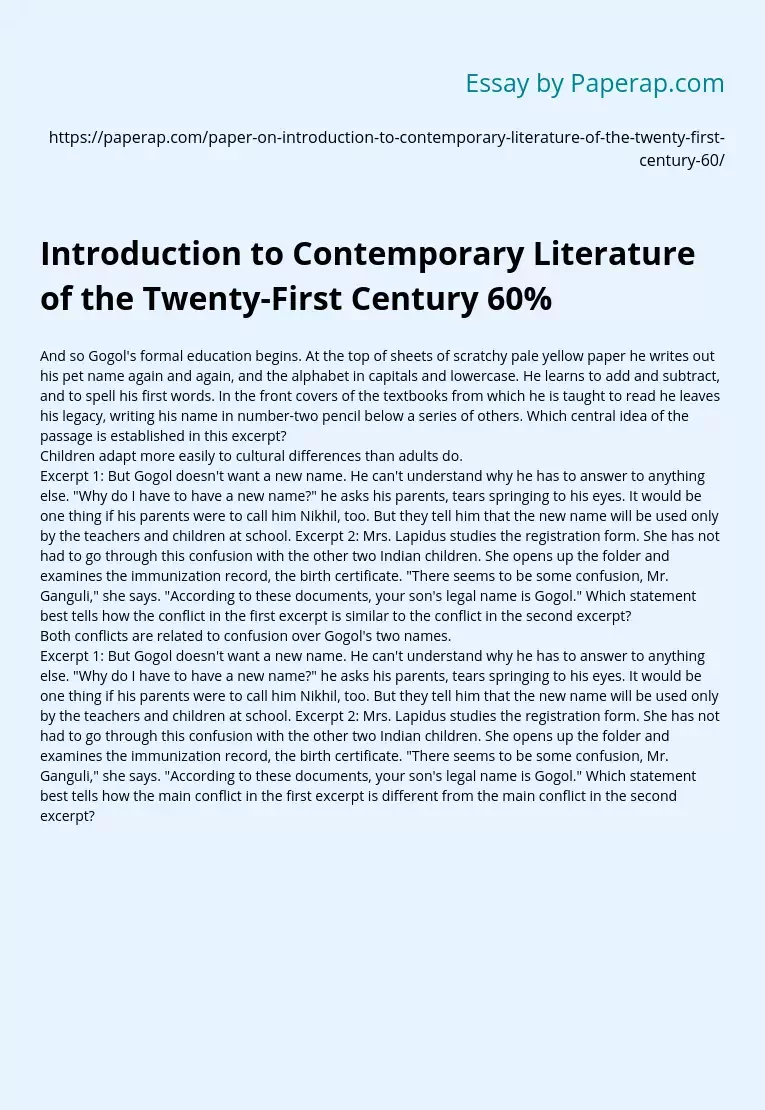Introduction to Contemporary Literature of the Twenty-First Century 60%
Which central idea of the passage is established in this excerpt?
Excerpt 2: Mrs. Lapidus studies the registration form. She has not had to go through this confusion with the other two Indian children. She opens up the folder and examines the immunization record, the birth certificate. “There seems to be some confusion, Mr. Ganguli,” she says. “According to these documents, your son’s legal name is Gogol.”
Which statement best tells how the conflict in the first excerpt is similar to the conflict in the second excerpt?
Excerpt 2: Mrs. Lapidus studies the registration form. She has not had to go through this confusion with the other two Indian children. She opens up the folder and examines the immunization record, the birth certificate. “There seems to be some confusion, Mr. Ganguli,” she says. “According to these documents, your son’s legal name is Gogol.”
Which statement best tells how the main conflict in the first excerpt is different from the main conflict in the second excerpt?
Which statement best describes the conflict revealed in this excerpt?
Which choice best states a conflict revealed in this excerpt?
Based on the excerpt, which statement best says how Lahiri explores the cultural conflict experienced by immigrant families?
Lahiri uses dialogue to show how cultural conflict can lead immigrant families to reject their native languages in an effort to resolve the conflict.
NOT!!
Lahiri uses description to explain how immigrant families avoid cultural conflict by using English to communicate with each other outside of the home.
When they are alone, Mrs. Lapidus asks, “Are you happy to be entering elementary school, Gogol?”
“My parents want me to have another name in school.”
“And what about you, Gogol? Do you want to be called by another name?”
After a pause, he shakes his head.
“Is that a no?”
He nods. “Yes.”
“Then it’s settled. Can you write your name on this piece of paper?”
Which best describes the conflict revealed by the conversation in this excerpt?
When they are alone, Mrs. Lapidus asks, “Are you happy to be entering elementary school, Gogol?”
“My parents want me to have another name in school.”
“And what about you, Gogol? Do you want to be called by another name?”
After a pause, he shakes his head.
“Is that a no?”
He nods. “Yes.”
“Then it’s settled. Can you write your name on this piece of paper?”
Which statement best says how Lahiri explores the cultural conflicts experienced by immigrant children?
Which central idea of the passage is established in this excerpt?
Excerpt 2: It is nothing like the schooling Gogol’s parents have known, fountain pens and polished black shoes and notebooks and good names and sir or madam at a tender age. Here the only official ritual is pledging allegiance first thing in the morning to the American flag.
Which statement best tells how the main conflict in the first excerpt is different from the main conflict in the second excerpt?
Gogol looks down at his sneakers. The way the principal pronounces his new name is different from the way his parents say it, the second part of it longer, sounding like “heel.”
She bends down so that her face is level with his, and extends a hand to his shoulder. “Can you tell me how old you are, Nikhil?”
When the question is repeated and there is still no response, Mrs. Lapidus asks, “Mr. Ganguli, does Nikhil follow English?”
“Of course he follows,” Ashoke says. “My son is perfectly bilingual.”
In order to prove that Gogol knows English, Ashoke does something he has never done before, and addresses his son in careful, accented English. “Go on, Gogol,” he says, patting him on the head. “Tell Mrs. Lapidus how old you are.”
Which line from this excerpt reflects the central idea that immigrants sometimes face discrimination and prejudice in their new culture?
Which central idea of the passage is established in this excerpt?
Excerpt 2: At the end of his first day he is sent home with a letter to his parents from Mrs. Lapidus, folded and stapled to a string around his neck, explaining that due to their son’s preference he will be known as Gogol at school. What about the parents’ preference? Ashima and Ashoke wonder, shaking their heads.
Which statement best tells how the main conflict in the first excerpt is different from the main conflict in the second excerpt?
The first excerpt illustrates a resolved conflict, while the second excerpt illustrates an ongoing conflict.
Introduction to Contemporary Literature of the Twenty-First Century 60%. (2018, Feb 20). Retrieved from https://paperap.com/paper-on-introduction-to-contemporary-literature-of-the-twenty-first-century-60/

